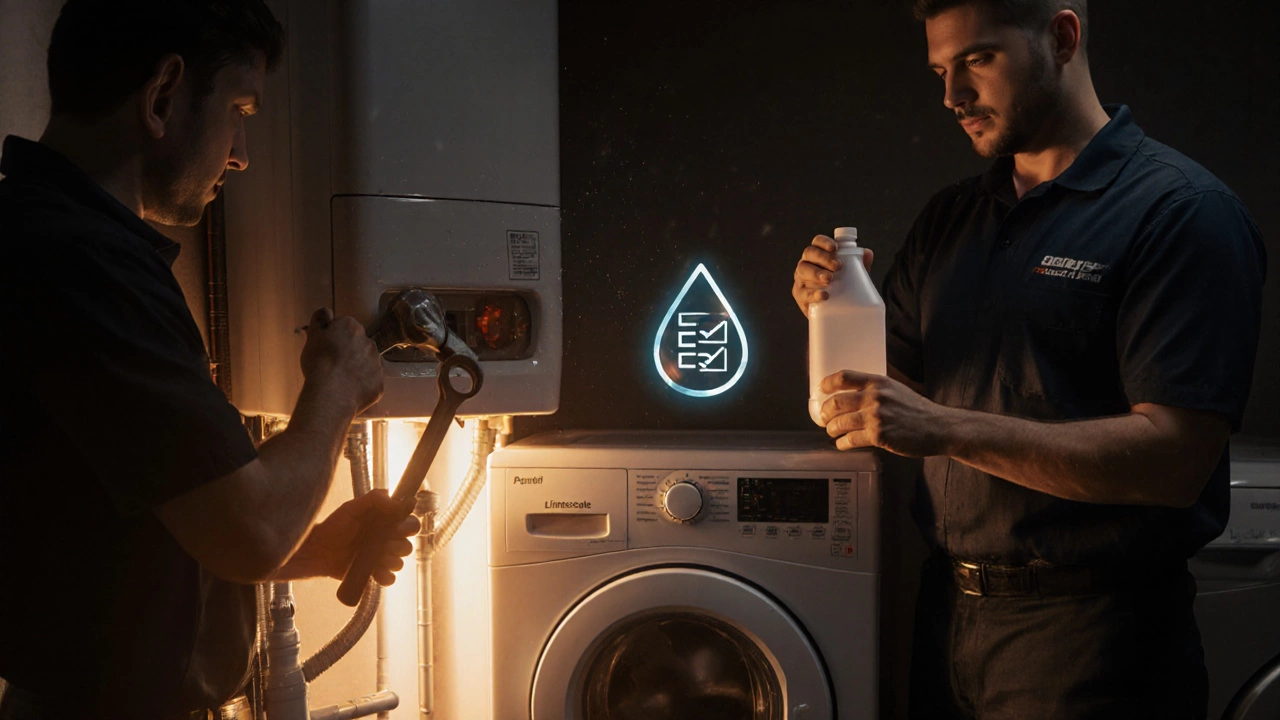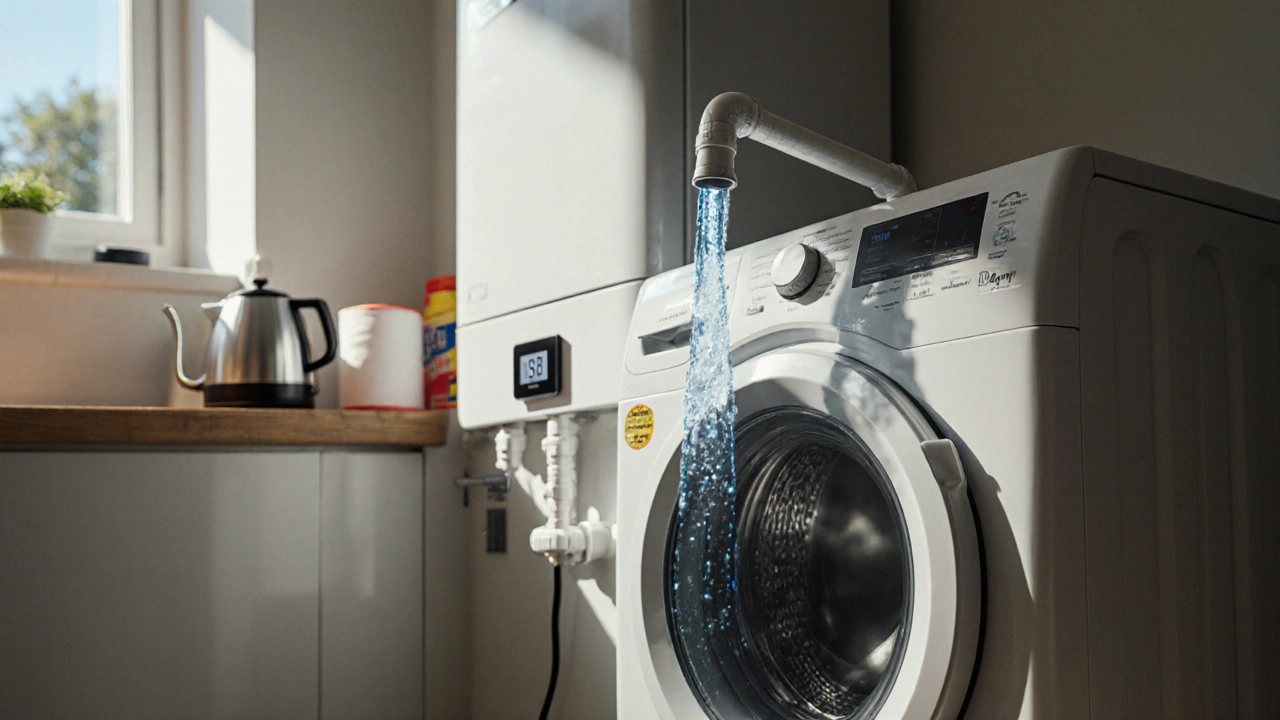Washing Machine Cycle Checker
Check if Your Cycle Can Run Without Hot Water
Select your washing machine cycle to see if it can run effectively when your boiler is broken
Cycle Recommendation
Select a cycle to see the recommendation
When the washing machine a household appliance that cleans clothes by tumbling them with water and detergent depends on a boiler a device that heats water for domestic use, usually powered by gas or electricity, a sudden outage can feel like a double‑whammy. Will the machine still spin? Will the laundry come out clean? Below we break down exactly what a broken boiler means for your washer and give you practical steps to keep the laundry day rolling.
How a washing machine gets its hot water
Most modern washers in New Zealand are designed to pull hot water straight from the domestic hot‑water system. The hot‑water inlet connects to the same pipe that feeds taps, showers, and the kitchen sink. When you select a 40 °C, 60 °C, or a sanitise cycle, the machine opens a valve that allows hot water to flood the drum, mixing it with cold water to hit the programmed temperature.
If the boiler is non‑functional, the hot‑water pipe delivers only cold water. The washer’s internal temperature sensor will notice the missing heat and either lower the final wash temperature or abort the cycle, depending on the model.
What changes when the boiler is out of service
- Lower water temperature - Even if you set a 60 °C wash, the actual temperature may stay around 20-25 °C because the machine can only use cold water.
- Longer wash times - Some machines compensate by extending the wash or adding extra rinses to ensure dirt removal.
- Reduced cleaning efficiency - Enzyme‑based detergents rely on warm water to activate. In cold water they work slower, so stains like grease, oil, or blood may linger.
- Impact on special cycles - Wool, silk, and sanitise programs are calibrated for warm or hot water. Running them cold can damage delicate fibers or render the sanitise function ineffective.
In short, the washer will still tumble, spin, and drain, but the quality of the clean drops noticeably.
Which cycles really need hot water?
Not every load demands heat. Here’s a quick guide:
| Cycle | Typical Temp. | Hot‑Water Needed? |
|---|---|---|
| Quick Wash (30 °C) | 30 °C | No - uses cold or blended water |
| Active Wear / Sports | 40 °C | Beneficial - helps break down sweat and odor |
| Sanitise / Hygiene | ≥60 °C | Essential - kills germs, removes allergens |
| Wool / Delicates | 30 °C (cold‑wash version) | Usually not needed - manufacturers advise cold |
| Heavy Duty (e.g., bedding) | 60 °C | Important - loosens oils and dust mites |
When the boiler is down, stick to cycles that can run on cold or blended water without compromising the fabric.
Workarounds you can try today
- Pre‑heat water manually - Fill a large bucket with hot tap water from a kettle or portable heater, then pour it into the washer’s drum before starting. Make sure the total volume matches the machine’s water‑level indicator.
- Use warm‑water‑boost detergents - Brands like Persil Power Gel are formulated to work in lower temperatures.
- Extend the soak - If your machine has a “pre‑wash” or “soak” option, enable it. Soaking for 15-20 minutes helps loosen grime before the cold wash.
- Switch to eco‑cycles - Many modern washers have an “Eco Cold” mode that optimises drum movement and spin speed for cold water.
- Combine loads - Reduce the number of wash cycles you run while the boiler is broken. Fewer loads mean fewer chances for sub‑par cleaning.
Boiler types and how they affect your laundry
Understanding the type of boiler in your home helps you gauge the impact of a failure.
- Gas‑fed (combustion) boiler - Heats water quickly and usually supplies higher temperatures (up to 75 °C). When it breaks, you lose a lot of heat fast.
- Electric (immersion) boiler - Takes longer to heat but can still deliver a steady 60 °C. A fault here often shows as a total loss of hot water.
- Indirect (heat‑exchanger) system - Uses a separate coil to transfer heat from the boiler to the water tank. If the primary boiler fails, the coil stops heating, leaving the tank cold.
Regardless of the type, the immediate symptom for your washer is the same: no hot water.
Potential risks of running a cold‑water wash for too long
Running every load cold isn’t fatal to the machine, but a few issues can arise:
- Detergent residue - Some powders don’t dissolve well in cold water, leaving film on fabrics and inside the drum.
- Increased limescale buildup - Cold water can carry more dissolved minerals, and the lack of heat means the built‑in water‑softening cycles work less efficiently.
- Energy consumption - Modern washers are tuned to use hot water efficiently. Running many long cold cycles may actually use more electricity because the motor works harder to compensate for reduced cleaning power.
These problems are manageable with regular maintenance: run a cleaning cycle once a month, wipe the door seal, and descale the inlet filter.

When to call a professional
Here’s a quick decision tree:
- If you only need a few light loads (t‑shirts, sheets) and can use the workarounds above, you can postpone a boiler call.
- If you have infants, elderly, or immunocompromised members at home, avoid sanitise cycles on cold water - call a boiler technician.
- When you notice no hot water from any tap, or the boiler’s pressure gauge stays flat, it’s time for a qualified plumber or gas‑engineer.
- If the washing machine itself shows error codes (e.g., “E‑04” on Samsung models) that reference water temperature, have a appliance‑repair specialist check the inlet valve and temperature sensor.
Getting both the boiler and the washer inspected together can save you time, especially if the issue lies in the shared plumbing.
Key Takeaways
- A broken boiler doesn’t stop the washing machine boiler broken from tumbling, but it will run on cold water only.
- Hot‑water‑dependent cycles (sanitise, heavy‑duty) lose effectiveness; switch to cold‑friendly programs.
- Manual hot‑water addition, cold‑boost detergents, and extended soak times help bridge the gap.
- Watch for detergent residue and limescale; clean the washer regularly.
- Call a professional if you need hot water for health‑critical loads or if the whole house lacks hot water.
Frequently Asked Questions
Can I use a washing machine without any hot water at all?
Yes. The drum will still fill, agitate, spin, and drain. The main difference is cleaning power-cold water works fine for lightly soiled items but may leave stains on heavier loads.
Will my washing machine be damaged by a prolonged cold‑water only operation?
The machine itself isn’t harmed, but mineral deposits can accumulate faster in the inlet valve and drum seals. Regular cleaning cycles and occasional descaling keep it healthy.
Do modern washers have built‑in water heaters?
A few high‑end models include an internal heating element for a short boost, but most rely entirely on the home boiler. Check the user manual; the spec sheet will list “internal heater” if present.
Is it safe to add boiling water from a kettle into the drum?
Pouring a small amount of very hot water (just off the boil) is okay for a quick temperature bump, but avoid overfilling the drum. Too much hot water can overflow and cause leaks.
What signs show that my boiler repair is urgent for laundry purposes?
If the pressure gauge stays below 1 bar, if you hear unusual noises, or if the boiler trips the safety valve, call a professional immediately. Those issues usually mean the boiler can’t heat water at all.
